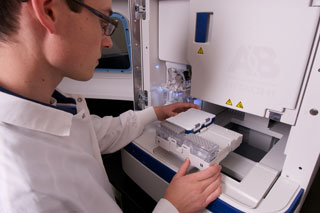Testing Locations
- Salt Lake City, UT, USA
- Itasca, IL, USA
- Ontario, CA, USA
- Mexico City, Mexico
- Leuven, Belgium
- Petit-Rechain, Belgium
- Ratigny, France
- Weisbaden, Germany
- Shanghai, China
Learn more about our locations and their certifications.
Study Outline
The Organism Identification tests are performed following bioburden, environmental monitoring, tissue testing, microbial limits, and on sterility or BI positives.
Test systems available are:
- MicroSeq® library and an Applied Biosystems/Hitachi 3500xL Genetic Analyzer
- Gram stain
Gram stain: Isolated colonies are examined for colony morphology, Gram reaction and cell morphology.
Genetic identification: This uses DNA instead of traditional biochemical reactions. It entails collecting the DNA from a microorganism (16S ribosomal DNA for bacteria and D2 region ribosomal DNA for fungi), creating many copies of the target region, then sequencing and comparing the unknown sequence to the MicroSeq library. If a match is not found in the MicroSeq library, a public database may be searched.
A Gram stain is typically performed along with all genetic identifications. This is done to ensure a pure culture, and to determine if unknown organisms are bacteria or yeast. It also provides a phenotypic component which makes the identification more complete.
If you have additional questions about Microbial Identification test services, or would like to consult with the experts at Nelson Labs, just send us a request or call us at +1 (801) 290-7500.



